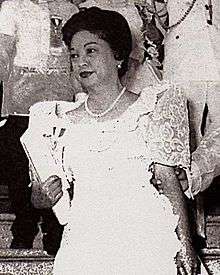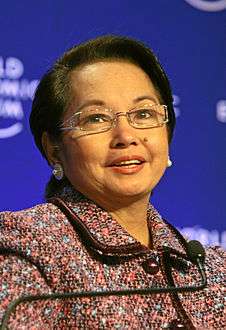Eva Macapagal
Evangelina "Eva" Macaraeg Macapagal gcYC (born Evangelina de la Cruz Macaraeg; November 1, 1915 – May 16, 1999) was the second wife of Diosdado Macapagal, the ninth President of the Philippines. She was the ninth First Lady of the Philippines, and the mother of the fourteenth President, Gloria Macapagal Arroyo.
Evangelina Macaraeg Macapagal | |
|---|---|
 Macapagal in 1961, on the day of her husband's inauguration | |
| 9th First Lady of the Philippines | |
| In role December 30, 1961 – December 30, 1965 | |
| President | Diosdado Macapagal |
| Preceded by | Leonila Garcia |
| Succeeded by | Imelda Marcos |
| Second Lady of the Philippines | |
| In office December 30, 1957 – December 30, 1961 | |
| President | Carlos P. Garcia |
| Preceded by | Leonila Garcia |
| Succeeded by | Edith Fabella-Pelaez |
| Personal details | |
| Born | Evangelica de la Cruz Macaraeg November 1, 1915 Binalonan, Pangasinan, Philippine Islands |
| Died | May 16, 1999 (aged 83) Manila, Philippines |
| Spouse(s) | |
| Relations | Arturo Macapagal (stepson) Cielo Macapagal Delgado (stepdaughter) |
| Children | Diosdado Jr. Gloria |
Biography
A physician by profession, Dr. Macapagal is notable for combining simplicity with graceful elegance during her term as the First Lady. She founded many of the health and education centers for the poor throughout the country, such as the Elsie Gaches Village, a center for the underprivileged south of Manila and financially supported the Medical Research Foundation of the Philippines. She campaigned for quality films and TV shows. She promoted the use of the patadyong kimona and the terno among women. She transformed Malacañang social events into impeccable opportunities for displaying simplicity, elegance, punctuality and cordiality.
Dr. Eva Macapagal was known for wearing the national dress whenever she had a chance to do so. She had a number of elegant ternos as well as maria claras for very formal occasions or state functions, but preferred to wear the patadyong kimona for its simplicity and for ease of movement. Eva favored a handful of Filipino couturiers, including Pitoy Moreno, who adhered to her style of simple but elegant lines.
Among Eva's projects as First Lady was the promotion of a locally-made, affordable and durable textile called the “Pag-asa cloth,” with prices within the reach of the daily wage earners. Eva herself and her teenage daughter Gloria wore some dresses fashioned from Pag-asa cloth to show its versatility and practical use in daily activities.
Dr. Macapagal is credited with transforming Malacañang from a dirty and dishevelled place to a clean and magnificent palace. Her training as a physician enabled her to bring about cleanliness and neatness in the rooms and appointments of the presidential residence. The Macapagals shared the view that Malacañang, being a historical structure intended for all presidents, should be sparingly remodeled and should not be tampered with for the individual convenience of temporary occupants.
Through repairs, refurnishing, repainting and redecoration, the necessary changes were effected in the palace without incurring additional expense. She frequently made inspection tours to ensure that the work was done fast, well and efficiently. She tended the grounds of the palace and the executive building as a garden, planted new trees and flowering shrubs, demolished old wooden structures, recommending that no new building be constructed in the Malacañang grounds to maintain the green spaces in the palace complex.
Dr. Macapagal discovered that the palace was rich in beautiful woodwork made of the finest native hardwood. She also discovered handsome pieces of furniture and decorations stacked in storerooms, offices and garages in the palace complex, which she salvaged and refurbished. Long-forgotten heirloom pieces were cleaned and polished and given places in different rooms, halls and walls around the palace. President Heinrich Luebke of Germany paid her a compliment when he said that having seen virtually all the palaces in the world, he believed that although not as large as other palaces, Malacañang was one of the best that could be found anywhere.
Honors




| Honorary titles | ||
|---|---|---|
| Preceded by Leonila Garcia |
First Lady of the Philippines 1961–1965 |
Succeeded by Imelda Marcos |
| Second Lady of the Philippines 1957–1961 |
Succeeded by Edith Pelaez | |

